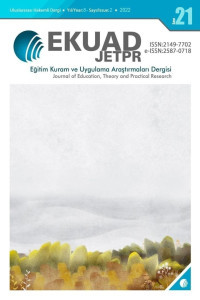Dinozorlaşma Sendromu: Bir Ölçek Geliştirme Çalışması
Dinozorlaşma ölçeği, Okul yöneticileri, Öğretmenler, Ölçek geliştirme
Dinosaur Syndrome: A Scale Development Study
Dinosaurization scale, School sdministrators, Teachers, Scale development,
___
- Balaman, F. & Baş, M. (2021). Adaptation of resistance to organizational change scale to Turkish: Validity-reliability study. Cumhuriyet International Journal of Education, 10 (2), 676-697. DOI: 10.30703/cije.751810.
- Bringselius, L. (2014) Employee objections to organizational change: A framework for addressing management responses. Organization Development Journal, 32(1), 41- 54.
- Büyüköztürk, Ş. (2002). Factor analysis: Basic concepts and its use in scale development. Retrieved on 07.12.2022 from https://dergipark.org.tr/tr/download/article-file/108451#:~:text=sener%20b%C3%BCy%C3%BCk%C3%B6zt%C3%BCrk&text=Daniel%20(1988)%20g%C3%C3%B6re,cited by Stapleton%2C%201997).
- Büyüköztürk, Ş. (2010). Data analysis handbook for social sciences. Ankara: Pegem Akademi.
- Can, A. (2021). Quantitative data analysis in the scientific research process with SPSS. Ankara: Pegem Akademi.
- Çalışkan, A. (2019). Resistance to change: A scale adaptation study. Journal of Süleyman Demirel University Faculty of Economics and Administrative Sciences, 24 (2), 237-252.
- Çınar, H. (2021). Dinosaur syndrome. In N. Cemaloğlu (Ed.), Reflections of syndromes on education and management. (159-173) in Ankara: Pegem Akademi.
- Çokluk, Ö., Şekercioğlu, G. & Büyüköztürk, Ş. (2012). Multivariate statistics for social sciences SPSS and LISREL Applications. Ankara: Pegem Akademi.
- Dent, E. B. & Goldberg, S. G. (1999). Challenging resistance to change. The Journal of Applied Behavioral Science, 35(1), 25-41. https://doi.org/10.1177/0021886399351003
- Ertürk Kayman, E. A. (2008). The level of realization of quantum leadership behaviors by the school administrators of the disseminator schools in the vocational education and training empowerment project (MEGEP) in Turkey. (Unpublished master's thesis). Hacettepe University, Institute of Educational Sciences, Ankara.
- George, D. & Mallery, M. (2010). SPSS for Windows step by step: A simple guide and reference. Boston, MA: Pearson Education, Inc.
- Gökbunar, R. & Ünal, A. G. (1999). Dinosaur syndrome in management and change in public administration. Atatürk University Journal of Economics and Administrative Sciences, 13(1), 45-58.
- Jain, P., Asrani, C. & Jain, T. (2018). Resistance to change in an organization. Retrieved from https://www.iosrjournals.org/iosr-jbm/papers/Vol20-issue5/Version-7/E2005073743.pdf on 07.12.2022.
- Kaptan, S. (1998). Scientific research and statistical techniques. Ankara: Tekışık Publications.
- Karasar, N. (2020). Scientific research method. Concepts principles techniques. Ankara: Nobel Academic Publishing.
- Karaxha, H. (2019). Methods for dealing with resistance to change. Baltic Journal of Real Estate Economics and Construction Management, 7, 290-299.
- Karsantık, İ. & Çetin, M. (2021). Development of the academic leadership scale: Validity and reliability study. Journal of Higher Education,11(3),671-681. DOI: 10.2399/yod.20.578370
- Kebabçı, S. & Erkal, H. (2009). Resistance to change- a constructive approach for managing resistant behaviors. Retrieved from http://www.diva-portal.se/smash/get/diva2:222586/FULLTEXT01.pdf on 07.12.2022.
- Konan, N. & Mermer, S. (2021). Quantum leadership scale: Validity and reliability study. E-International Journal of Pedagogy, 1(1), 74-86. Retrieved from https://www.e-ijpa.com/index.php/pedandragoji/article/view/13.
- Lawler, E. E. & Galbraith, J. R. (1994). Avoiding the Comorate I Dinosaur Syndrome. Retrieved from https://ceo.usc.edu/1994/05/21/avoiding-the-corporate-dinosaur-syndrome/ on 07.12.2022.
- Marques, M. P. & Esposito, S.M. (2014). Improving change management: how communication nature influences resistance to change. Journal of Management Development, 33(4), 324 - 341.
- Meydan, C. H. & Şeşen, H. (2011). Structural equation modeling AMOS applications. Ankara: Detay.
- Naktiyok, A. (2007). Innovation orientation and organizational factors. Atatürk University Journal of Economics and Administrative Sciences, 21(2), 211-230.
- Neyişçi, N. B. (2008). The level of realization of uncertainty avoidance behaviors of school administrators in the vocational education and training empowerment project (EGEP) in Turkey. Unpublished master’s Thesis, Institute of Social Sciences, Ankara.
- Özdemir, M. (2020). Human resources management. Ankara: Anı Publishing.
- Peterson, B. (2016). Signs that your company's a dinosaur and how to evolve. Accessed from https://www.inc.com/ben-peterson/3-signs-that-your-companys-a-dinosaur--andhow-to-evolve.html on 07.12.2022.
- Radzi, N.S. & Othman, R. (2016). Resistance to change: The moderating effects of leader-member exchange and role breadth self-efficacy. Journal of Advanced Management Science, 4(1).
- Schlechty, C. P. (2020). Rebuilding the school. Ankara: Remzi Kitabevi.
- Sönmez, V. & Alacapınar, G.F. (2019). Exemplified scientific research methods. Ankara: Anı Publishing.
- Tabachnick, B. G., & Fidell, L. S. (2013). Using multivariate statistics. Boston: Pearson.
- Tavşancıl, E. (2005). Measurement of attitudes and data analysis with SPSS. Ankara: Nobel Publishing.
- Tekindal, S. (2021). Quantitative qualitative mixed methods research designs and statistics. Ankara: Nobel Academic Publishing.
- Ulutaş, M. & Arslan, H. (2018). Informatics Leadership Scale: A Scale Development Study. Marmara University Atatürk Faculty of Education Journal of Educational Sciences, 47 (47), 105-124.DOI: 10.15285/maruaebd.2739
- Ulutaş, M. (2015). The relationship between informatics leadership, learning organization and university culture in higher education. Unpublished Doctoral Dissertation, Çanakkale Onsekiz Mart University.
- Yeşil, S. (2013). Selected topics from new management approach considering globalization and changing environmental dynamics. Ankara: Seçkin Publishing.
- Yurdakul, A. & Çelik, K. (2022). In-group commitment in educational organizations: A scale development study. Mersin University Journal of Faculty of Education, 18(2), 116-131.
- ISSN: 2149-7702
- Yayın Aralığı: Yılda 3 Sayı
- Başlangıç: 2015
- Yayıncı: Sabri SİDEKLİ
Examination of English Theses Written on “Critical Thinking” in Türkiye between 2000-2021
Duygu KORKUT, Şeyda ŞATIROĞLU, Anıl Doğukan SARIALAİ, Mehmet Kaan DEMİR
Dinozorlaşma Sendromu: Bir Ölçek Geliştirme Çalışması
Fırat YARDİMCİEL, Durmuş KILIÇ
An Analysis on Conflicts in Educational Organizations and Informal Mediator Roles
Öğretmenlerin Yabancılaşmasının Nedenleri
Derya GÖĞEBAKAN-YILDIZ, Ahmet GİRGİN, Pınar ŞENKAL
STEM Temelli Astronomi Etkinliklerinin Ortaokul Öğrencilerinin STEM ve Astronomi Tutumlarına Etkisi
